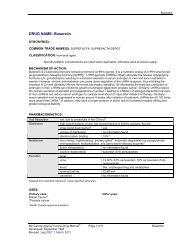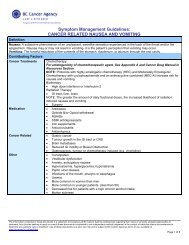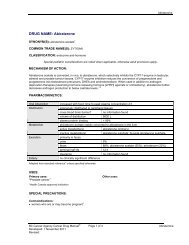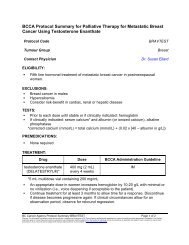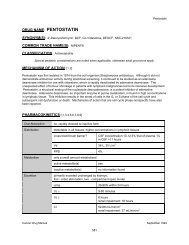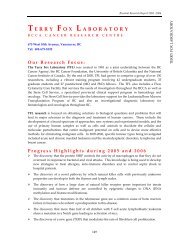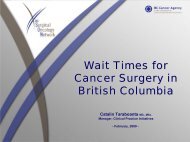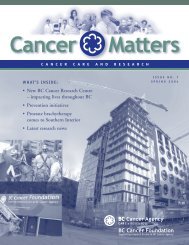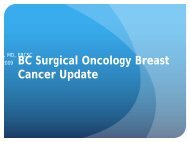Breast Cancer Surgery in Canada - BC Cancer Agency
Breast Cancer Surgery in Canada - BC Cancer Agency
Breast Cancer Surgery in Canada - BC Cancer Agency
Create successful ePaper yourself
Turn your PDF publications into a flip-book with our unique Google optimized e-Paper software.
<strong>Breast</strong> <strong>Cancer</strong> <strong>Surgery</strong> <strong>in</strong> <strong>Canada</strong>:<br />
What Do We Need to do and Document?<br />
Geoff Porter MD FACS FRCSC<br />
Vancouver, November 2009
• None<br />
Disclosures
Outl<strong>in</strong>e<br />
• <strong>Breast</strong> cancer surgery <strong>in</strong> <strong>Canada</strong> – current status<br />
• Synoptic report<strong>in</strong>g<br />
– Pathology<br />
–<strong>Surgery</strong><br />
• Synoptic Report<strong>in</strong>g Tools Project (SRTP)<br />
• Conclusions
<strong>Breast</strong> <strong>Cancer</strong> <strong>Surgery</strong> <strong>in</strong> <strong>Canada</strong><br />
N=519 surgeons<br />
100%<br />
80%<br />
60%<br />
76%<br />
40%<br />
20%<br />
0%<br />
15% 9%<br />
< 25% 25%-50% > 50%<br />
% practice related to breast disease<br />
Porter and MacMulk<strong>in</strong>, World J Surg 2004
<strong>Breast</strong> <strong>Cancer</strong> <strong>Surgery</strong> <strong>in</strong> <strong>Canada</strong><br />
N=519 surgeons<br />
100%<br />
80%<br />
In Atlantic <strong>Canada</strong>, 51% do < 3 cases/month<br />
60%<br />
40%<br />
20%<br />
0%<br />
42%<br />
37%<br />
15%<br />
7%<br />
< 3 3 to 5 6 to 10 > 10<br />
<strong>Breast</strong> cancer cases/month<br />
Porter and MacMulk<strong>in</strong>, World J Surg 2004
<strong>Breast</strong> <strong>Cancer</strong> <strong>Surgery</strong> <strong>in</strong> <strong>Canada</strong><br />
N=519 surgeons<br />
100%<br />
80%<br />
60%<br />
40%<br />
20%<br />
0%<br />
55%<br />
Community<br />
28%<br />
Community with<br />
University<br />
affiliation<br />
17%<br />
University<br />
Practice Sett<strong>in</strong>g<br />
Porter and MacMulk<strong>in</strong>, World J Surg 2004
<strong>Breast</strong> <strong>Cancer</strong> <strong>Surgery</strong> <strong>in</strong> <strong>Canada</strong><br />
N=519 surgeons<br />
100%<br />
80%<br />
In Atlantic <strong>Canada</strong>, 71% surgeons work <strong>in</strong><br />
community with population < 50,000<br />
60%<br />
40%<br />
20%<br />
38% 36%<br />
26%<br />
0%<br />
< 50,000 50,000 to 500,000 > 500,000<br />
Population <strong>in</strong> Surgeon Community<br />
Porter and MacMulk<strong>in</strong>, World J Surg 2004
SLN Biopsy <strong>in</strong> <strong>Breast</strong> Ca – Fad or Fruit?<br />
• Axillary node sampl<strong>in</strong>g<br />
• High dose chemo and BM transplant<br />
or<br />
• <strong>Breast</strong> conserv<strong>in</strong>g surgery<br />
• Hormonal therapy
<strong>Breast</strong> <strong>Cancer</strong> <strong>Surgery</strong> <strong>in</strong> <strong>Canada</strong>:<br />
Uptake of SLN Biopsy<br />
100%<br />
Majority (60%)<br />
due to lack of resources<br />
80%<br />
60%<br />
40%<br />
61%<br />
20%<br />
0%<br />
27%<br />
2001 2006<br />
% Canadian surgeons perform<strong>in</strong>g SLN Biopsy<br />
Porter et al. Annals Surg Oncol 2004; Quan et al. <strong>Breast</strong> J 2008
Surgeons Not Perform<strong>in</strong>g SLN Bx<br />
N=381<br />
• Reasons for not perform<strong>in</strong>g SLN Bx:<br />
1. Lack of adequate resources (64%)<br />
2. Insufficient evidence for SLN Bx (29%)<br />
3. Lack of comfort with technique of SLN Bx (22%)<br />
Porter and MacMulk<strong>in</strong>, Ann Surg Onc 2003
SLN Bx Technique <strong>in</strong> 2001<br />
N=138<br />
12%<br />
9%<br />
Dye alone<br />
Tracer alone<br />
Both<br />
79%<br />
Porter and MacMulk<strong>in</strong>, Ann Surg Onc 2003
SLN Bx Technique <strong>in</strong> 2006<br />
N=306<br />
4%<br />
18%<br />
Dye alone<br />
Tracer alone<br />
Both<br />
78%<br />
Quan et al. <strong>Breast</strong> J 2008
Method Of Learn<strong>in</strong>g SLN Bx<br />
N=138<br />
24%<br />
14%<br />
11%<br />
51%<br />
Course<br />
Fellowship<br />
Observe/mentor<br />
Self-taught<br />
Porter and MacMulk<strong>in</strong>, Ann Surg Onc 2003
Method Of Learn<strong>in</strong>g SLN Bx<br />
<strong>in</strong> 2006 (N=138)<br />
39%<br />
5%<br />
22%<br />
34%<br />
Course<br />
Fellowship<br />
Observe/mentor<br />
Self-taught<br />
Quan et al. <strong>Breast</strong> J 2008
Highest Acceptable False Negative Rate<br />
<strong>in</strong> 2001 (N=138)<br />
2%<br />
10%<br />
Highest Acceptable False Negative Rate<br />
<strong>in</strong> 2006 (N=306)<br />
3%<br />
22%<br />
Number of Concurrent SLN Bx & ALND<br />
Before Abandonment ALND <strong>in</strong> 2001<br />
15%<br />
49%<br />
36%<br />
10 or fewer<br />
11 to 30<br />
31 or more<br />
Porter and MacMulk<strong>in</strong>, Ann Surg Onc 2003
Number of Concurrent SLN Bx & ALND<br />
Before Abandonment ALND <strong>in</strong> 2006<br />
10%<br />
38% 10 or fewer<br />
11 to 30<br />
31 or more<br />
52%<br />
Quan et al. <strong>Breast</strong> J 2008
<strong>Breast</strong> <strong>Cancer</strong> <strong>Surgery</strong> <strong>in</strong> <strong>Canada</strong><br />
More Data<br />
• Among surgeons treat<strong>in</strong>g breast cancer:<br />
– 57% have immediate breast reconstruction available at<br />
their <strong>in</strong>stitution<br />
– 79% felt “most general surgeons” should perform<br />
breast cancer surgery<br />
– 71% are satisfied with proportion of practice related to<br />
breast disease<br />
Porter and MacMulk<strong>in</strong>, World J Surg 2004
<strong>Breast</strong> <strong>Cancer</strong> <strong>Surgery</strong> <strong>in</strong> <strong>Canada</strong><br />
• We are thoughtful adopters<br />
• Resources are an important issue<br />
• Particularly services/resources outside doma<strong>in</strong><br />
of the general surgeon<br />
• “Ripe” for some <strong>in</strong>terprov<strong>in</strong>cial <strong>in</strong>itiatives
Outl<strong>in</strong>e<br />
• <strong>Breast</strong> cancer surgery <strong>in</strong> <strong>Canada</strong> – current status<br />
• Synoptic report<strong>in</strong>g<br />
– Pathology<br />
–<strong>Surgery</strong><br />
• Synoptic Report<strong>in</strong>g Tools Project (SRTP)<br />
• Conclusions
What is Synoptic Report<strong>in</strong>g?<br />
• Standardized process to capture data accord<strong>in</strong>g to<br />
predeterm<strong>in</strong>ed variables and def<strong>in</strong>itions<br />
• Can be text based or digital
Synoptic Report<strong>in</strong>g<br />
Why?<br />
• Commonly-cited benefits<br />
– Improves content and completeness of reports<br />
– Reduces risk of mis<strong>in</strong>terpretation of f<strong>in</strong>d<strong>in</strong>gs<br />
– Improves communications among health care<br />
professionals<br />
– Increase efficiency/decrease cost of report<br />
creation/distribution<br />
→ Most data
What are Known Benefits of Synoptic Report<strong>in</strong>g?<br />
Pathology<br />
• Narrative breast cancer report<strong>in</strong>g (n=120)<br />
– 100% histologic type<br />
– 90% size<br />
– 90% grade<br />
– 25% marg<strong>in</strong>s oriented properly<br />
– 47% lymphovascular <strong>in</strong>vasion<br />
• Clear room for improvement<br />
Wilk<strong>in</strong>son et al. JACS 2003
What are Known Benefits of Synoptic Report<strong>in</strong>g?<br />
Pathology<br />
• Implement computerized pathology report<strong>in</strong>g<br />
(cluster) randomized trial (n=2042 reports)<br />
– 28.4% (95% CI 15.7%-41.2%) <strong>in</strong>crease <strong>in</strong> complete<br />
reports for registry purposes<br />
– 24.5% (95% CI 11.0%-38.0%) <strong>in</strong>crease <strong>in</strong> complete<br />
reports for patient management<br />
– Acceptable to pathologists, preferred by cl<strong>in</strong>icians<br />
Branston et al. Eur J <strong>Cancer</strong> 2002
What are Known Benefits of Synoptic Report<strong>in</strong>g?<br />
<strong>Surgery</strong><br />
• Non-randomized comparison of narrative vs. web-based<br />
synoptic report (WebSMR) for rectal cancer surgery<br />
– Overall complete specified data elements <strong>in</strong>creased with<br />
synoptic report (99% vs. 45.9%; p
Why Synoptic Surgical Report<strong>in</strong>g <strong>in</strong><br />
<strong>Breast</strong> <strong>Cancer</strong>?<br />
• Common cancer<br />
• Well-established treatment guidel<strong>in</strong>es<br />
– <strong>Surgery</strong> common treatment – def<strong>in</strong>able<br />
– In most patients, surgery is <strong>in</strong>itial treatment and surgeon is<br />
the “quarterback” of subsequent care<br />
• Operative reports conta<strong>in</strong> critical medical <strong>in</strong>formation<br />
– Dictated and text-based, frequently <strong>in</strong>complete, vague<br />
• Potential knowledge translation tool
Some Excerpts<br />
• Indications for surgery: “This patient had confirmed breast cancer<br />
and presents for surgery today.”<br />
• Details of Procedure:“Follow<strong>in</strong>g prepp<strong>in</strong>g and drap<strong>in</strong>g, a standard<br />
mastectomy <strong>in</strong>cision was made and standard mastectomy was<br />
performed with usual landmarks and flaps. The lower axilla was<br />
removed with the tail of the breast. Vessels and lymphatic<br />
channels were clipped with medium clips or ligated with 2.0 vicryl<br />
ties or suture ligated with 3.0 vicryl. The sk<strong>in</strong> was closed with 7<br />
buried <strong>in</strong>terrupted 3.0 vicryl sutures and 4.0 PDS was used to close<br />
the sk<strong>in</strong>, with myself and the assistant sutur<strong>in</strong>g <strong>in</strong> oppos<strong>in</strong>g<br />
directions.”
Mis<strong>in</strong>terpretation
Dichotomy of Surgical <strong>Cancer</strong> Care<br />
Increas<strong>in</strong>gly complex decision mak<strong>in</strong>g and treatment<br />
vs.<br />
Large number of surgeons<br />
• Makes availability of population-based tool that can describe<br />
practice patterns and assist br<strong>in</strong>g<strong>in</strong>g important elements of<br />
care <strong>in</strong>to cl<strong>in</strong>ical practice extremely attractive
What is the Synoptic Report<strong>in</strong>g Tools<br />
Project (SRTP)?<br />
• Canadian Partnership Aga<strong>in</strong>st <strong>Cancer</strong> <strong>in</strong>itiative<br />
• Interprov<strong>in</strong>cial<br />
• Surgical report<strong>in</strong>g tool implementation<br />
• Three year pilot<br />
• Major evaluation component
Goal of <strong>Breast</strong> <strong>Cancer</strong> SRTP<br />
• More complete reports<br />
• More accurate reports<br />
• More timely reports<br />
• Vehicle for br<strong>in</strong>g<strong>in</strong>g practice guidel<strong>in</strong>es <strong>in</strong>to everyday<br />
practice<br />
• Provides cl<strong>in</strong>ically relevant and retrievable practice pattern<br />
<strong>in</strong>formation<br />
• Establish <strong>in</strong>ter-prov<strong>in</strong>cial relationships with regards to data<br />
collection, report<strong>in</strong>g, and use of synoptic tools
Interprov<strong>in</strong>cial Work<br />
• Five prov<strong>in</strong>ce representation on breast SRTP<br />
<strong>in</strong>terprov<strong>in</strong>cial template committee (<strong>BC</strong>, AB,<br />
MAN, QUE, NS)<br />
• Several revisions, prov<strong>in</strong>cial and society review<br />
and acceptance of content<br />
• Consensus on <strong>in</strong>terprov<strong>in</strong>cial template content<br />
(prov<strong>in</strong>cial issues identified)
Content of OR Report Driven by:<br />
• Cl<strong>in</strong>ical <strong>in</strong>formation needs<br />
– Surgeons<br />
– Other physicians<br />
– Other health care workers<br />
• Medical record needs<br />
• Medicolegal/regulatory needs<br />
• Bill<strong>in</strong>g needs<br />
• Research needs
•Demo<br />
What is WebSMR
Synoptic Surgical Report<strong>in</strong>g<br />
Pr<strong>in</strong>ciples of Pilot Implementation<br />
• At least time neutral for surgeon<br />
•Done with what surgeon has at end of case<br />
•Voluntary for surgeon<br />
• No duplicated dictated report – cost sav<strong>in</strong>gs<br />
• No detrimental IM step for facility/others
How is Implementation Go<strong>in</strong>g ?<br />
• Secur<strong>in</strong>g and nurtur<strong>in</strong>g partner support is critical<br />
• Integration of current IT health systems with a new<br />
system requires flexibility<br />
• Implementation has major IT and IM challenges<br />
• Focus on user acceptance and IT solutions<br />
• Surgeon buy-<strong>in</strong> not an issue to date (we are wait<strong>in</strong>g…)<br />
• Technology enables the solution, cannot be the focus
Conclusions<br />
• Important to understand demographics and practice<br />
patterns <strong>in</strong> breast cancer surgery<br />
• Big gap → national-level data relevant to surgical<br />
breast cancer care<br />
• Need to merge local/prov<strong>in</strong>cial cl<strong>in</strong>ical care<br />
benefits with a national <strong>in</strong>itiative vital<br />
– Will SRTP do this?
OR note:<br />
Standard<br />
surgery<br />
performed
Contact Information<br />
Geoff.Porter@dal.ca<br />
902 473-6499<br />
Andrea Hilchie-Pye<br />
Project Coord<strong>in</strong>ator<br />
Synoptic Report<strong>in</strong>g Tools Project<br />
473-6090<br />
andrea.hilchie-pye@<br />
ccns.nshealth.ca




